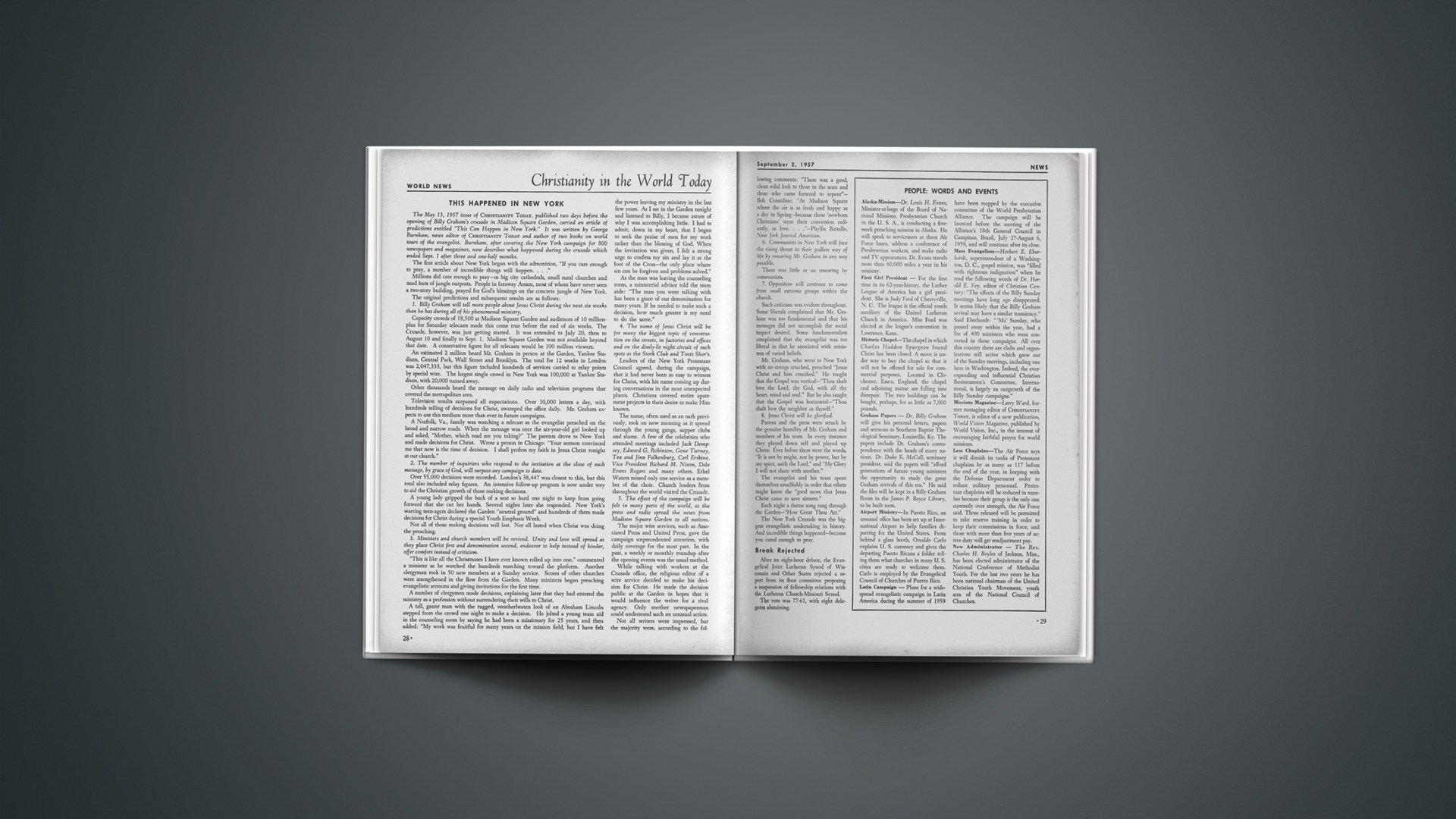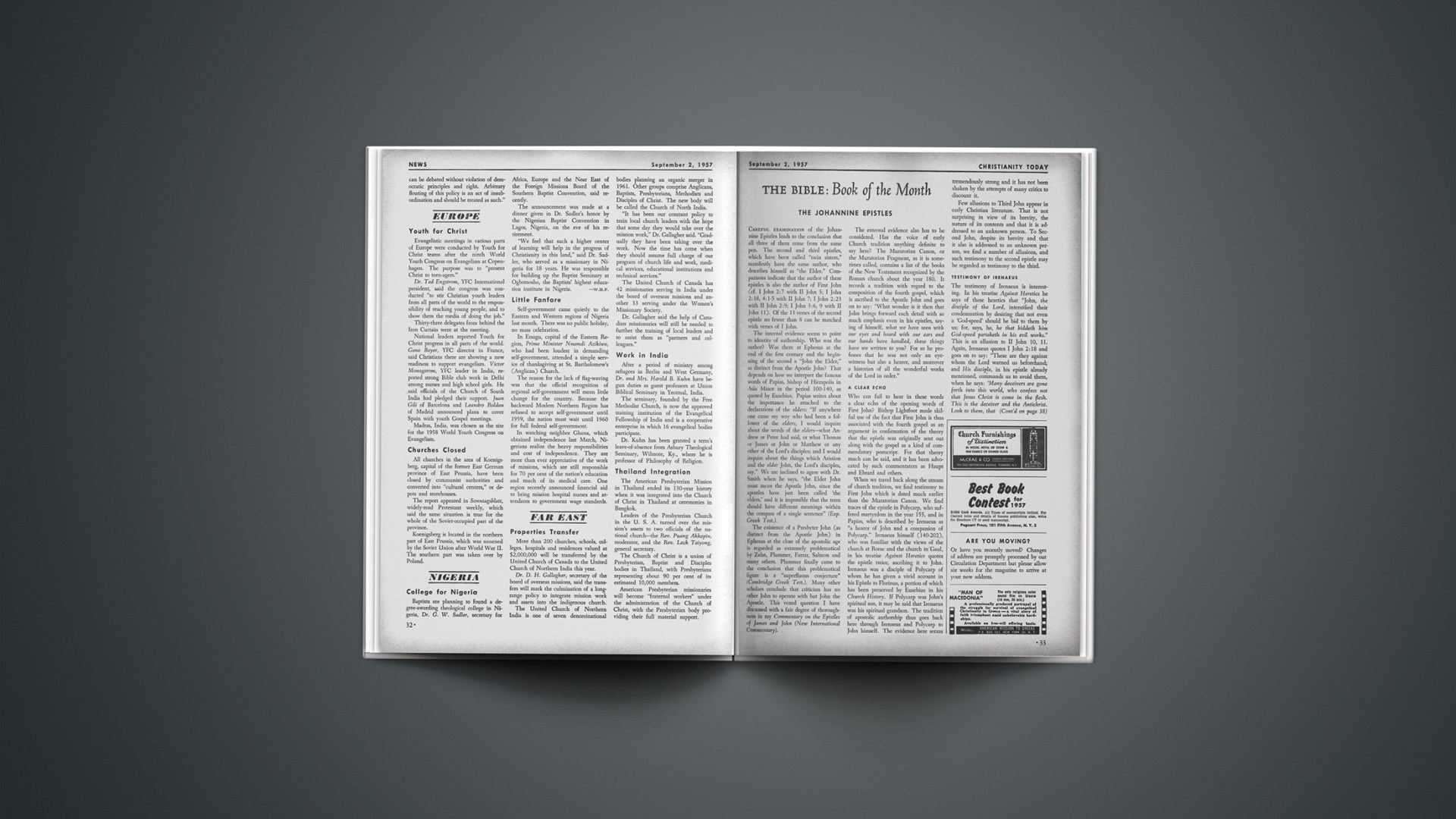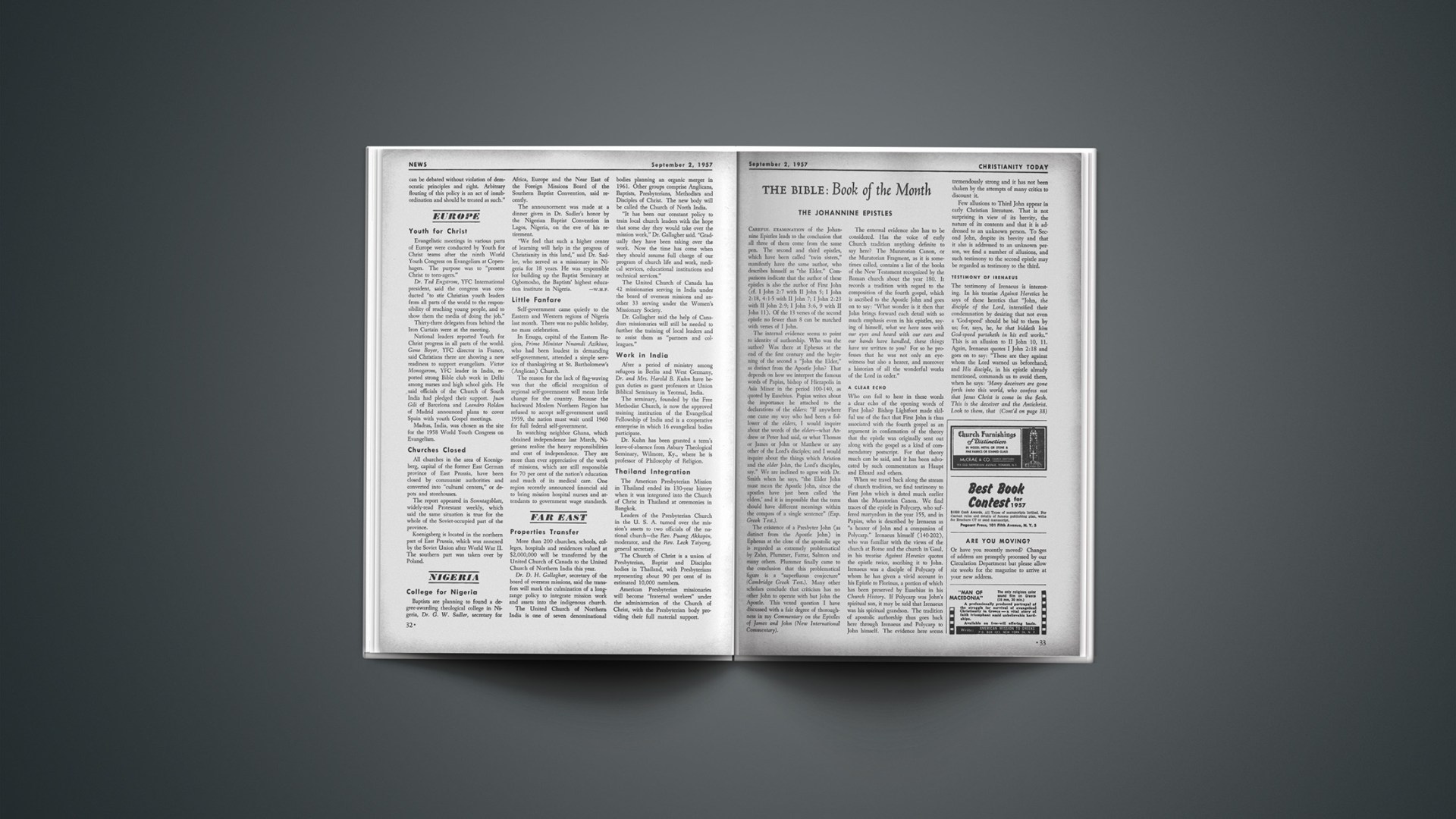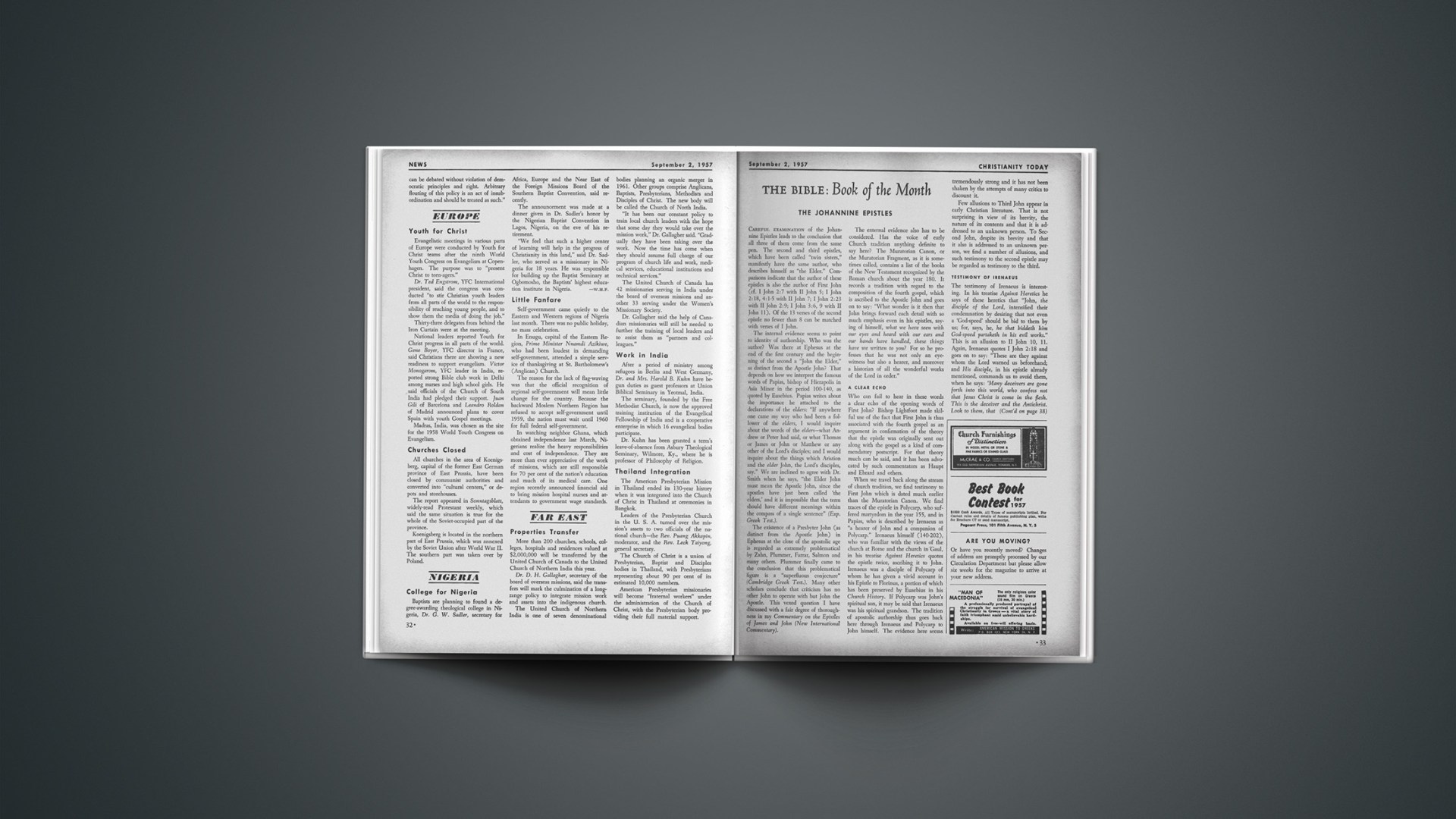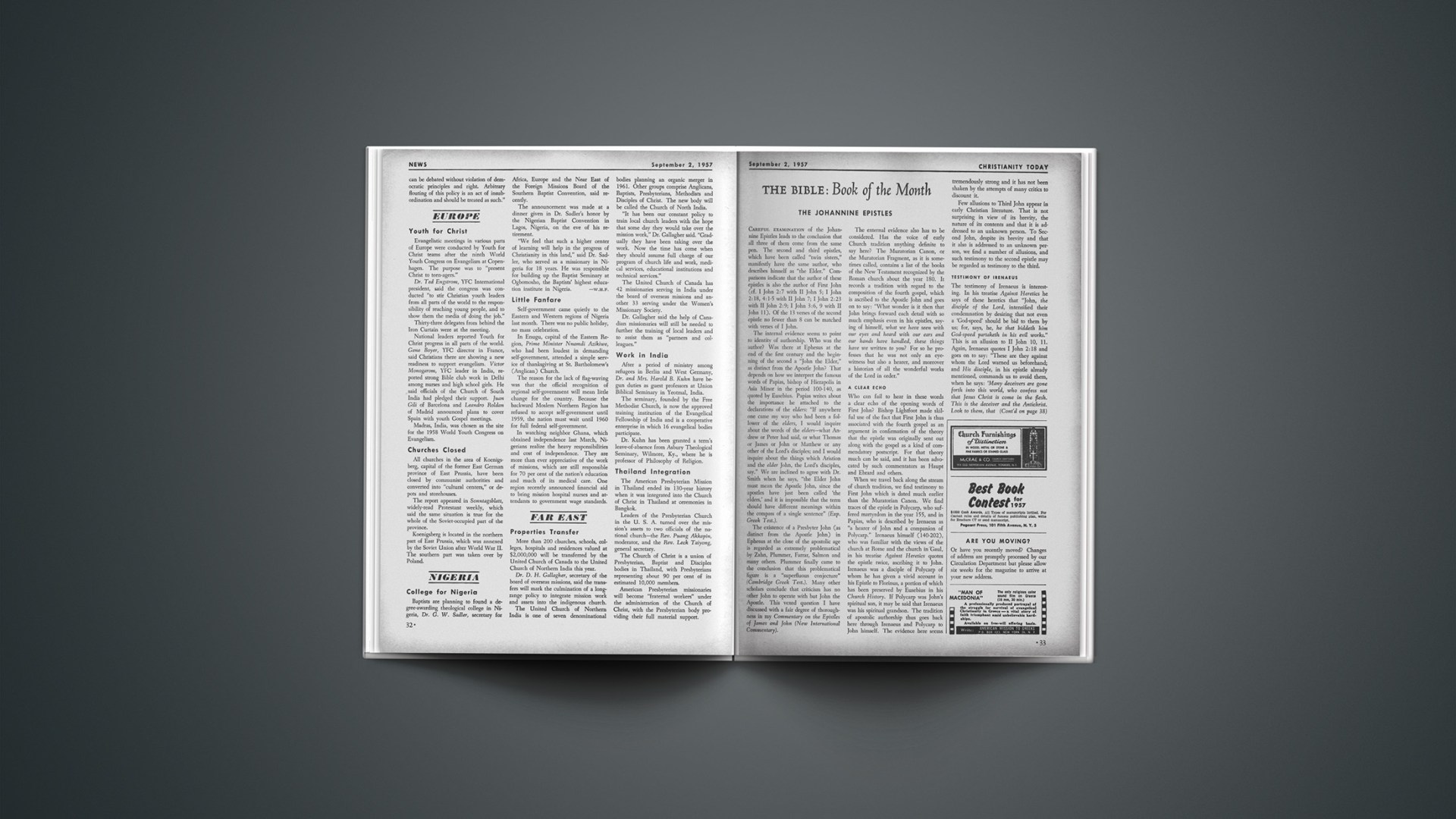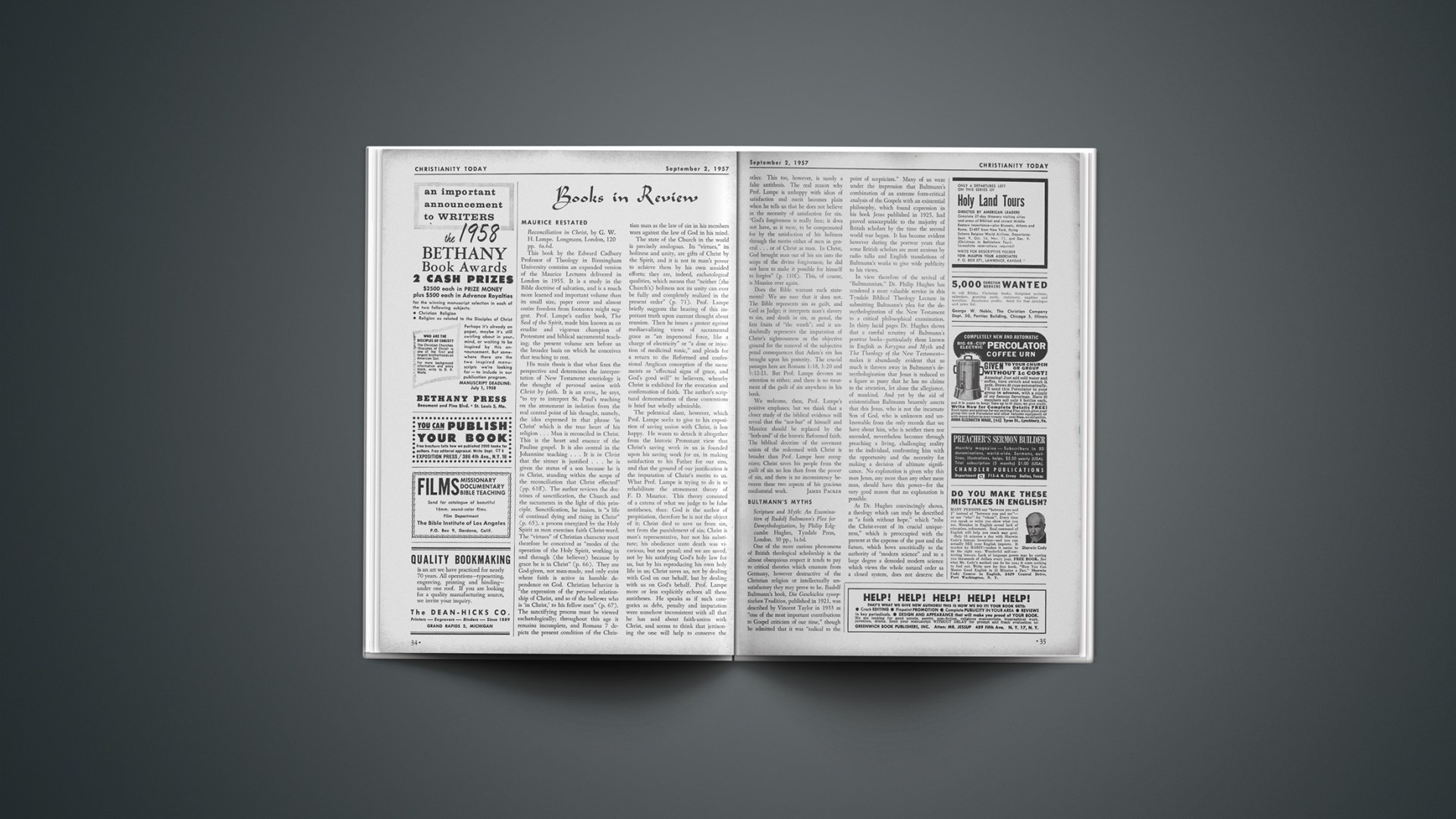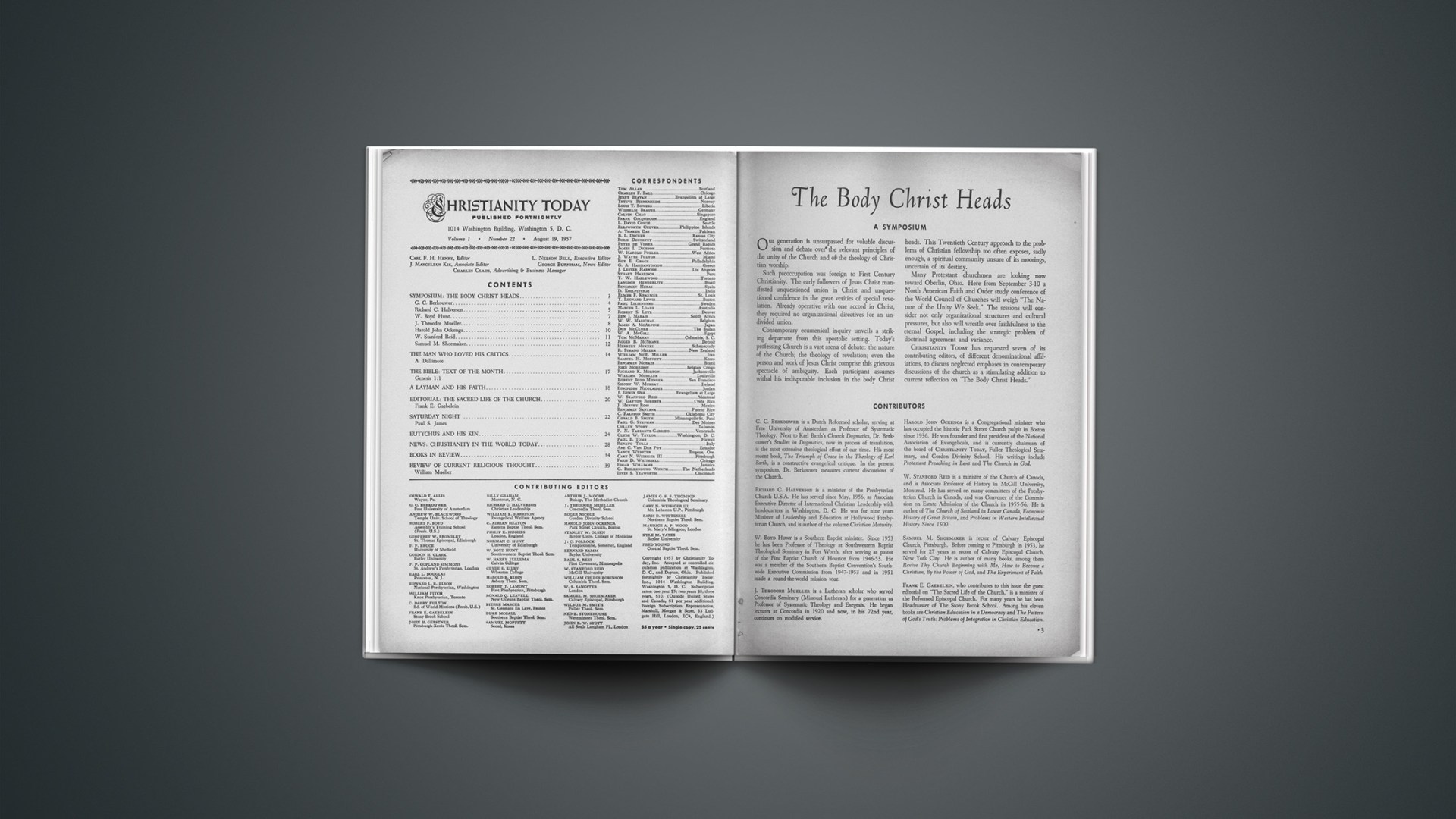WORLD NEWS
Christianity in the World Today
The May 13, 1957 issue ofCHRISTIANITY TODAY, published two days before the opening of Billy Graham’s crusade in Madison Square Garden, carried an article of predictions entitled “This Can Happen in New York.” It was written by George Burnham, news editor ofCHRISTIANITY TODAYand author of two books on world tours of the evangelist. Burnham, after covering the New York campaign for 800 newspapers and magazines, now describes what happened during the crusade which ended Sept. 1 after three and one-half months.
The first article about New York began with the admonition, “If you care enough to pray, a number of incredible things will happen.…”
Millions did care enough to pray—in big city cathedrals, small rural churches and mud huts of jungle outposts. People in faraway Assam, most of whom have never seen a two-story building, prayed for God’s blessings on the concrete jungle of New York.
The original predictions and subsequent results are as follows:
1. Billy Graham will tell more people about Jesus Christ during the next six weeks than he has during all of his phenomenal ministry.
Capacity crowds of 18,500 at Madison Square Garden and audiences of 10 million-plus for Saturday telecasts made this come true before the end of six weeks. The Crusade, however, was just getting started. It was extended to July 20, then to August 10 and finally to Sept. 1. Madison Square Garden was not available beyond that date. A conservative figure for all telecasts would be 100 million viewers.
An estimated 2 million heard Mr. Graham in person at the Garden, Yankee Stadium, Central Park, Wall Street and Brooklyn. The total for 12 weeks in London was 2,047,333, but this figure included hundreds of services carried to relay points by special wire. The largest single crowd in New York was 100,000 at Yankee Stadium, with 20,000 turned away.
Other thousands heard the message on daily radio and television programs that covered the metropolitan area.
Television results surpassed all expectations. Over 10,000 letters a day, with hundreds telling of decisions for Christ, swamped the office daily. Mr. Graham expects to use this medium more than ever in future campaigns.
A Norfolk, Va., family was watching a telecast as the evangelist preached on the broad and narrow roads. When the message was over the six-year-old girl looked up and asked, “Mother, which road are you taking?” The parents drove to New York and made decisions for Christ. Wrote a person in Chicago: “Your sermon convinced me that now is the time of decision. I shall profess my faith in Jesus Christ tonight at our church.”
2. The number of inquiriers who respond to the invitation at the close of each message, by grace of God, will surpass any campaign to date.
Over 55,000 decisions were recorded. London’s 38,447 was closest to this, but this total also included relay figures. An intensive follow-up program is now under way to aid the Christian growth of those making decisions.
A young lady gripped the back of a seat so hard one night to keep from going forward that she cut her hands. Several nights later she responded. New York’s warring teen-agers declared the Garden “neutral ground” and hundreds of them made decisions for Christ during a special Youth Emphasis Week.
Not all of those making decisions will last. Not all lasted when Christ was doing the preaching.
3. Ministers and church members will be revived. Unity and love will spread as they place Christ first and denomination second, endeavor to help instead of hinder, offer comfort instead of criticism.
“This is like all the Christmases I have ever known rolled up into one,” commented a minister as he watched the hundreds marching toward the platform. Another clergyman took in 50 new members at a Sunday service. Scores of other churches were strengthened in the flow from the Garden. Many ministers began preaching evangelistic sermons and giving invitations for the first time.
A number of clergymen made decisions, explaining later that they had entered the ministry as a profession without surrendering their wills to Christ.
A tall, gaunt man with the rugged, weatherbeaten look of an Abraham Lincoln stepped from the crowd one night to make a decision. He jolted a young team aid in the counseling room by saying he had been a missionary for 25 years, and then added: “My work was fruitful for many years on the mission field, but I have felt the power leaving my ministry in the last few years. As I sat in the Garden tonight and listened to Billy, I became aware of why I was accomplishing little. I had to admit, down in my heart, that I began to seek the praise of men for my work rather than the blessing of God. When the invitation was given, I felt a strong urge to confess my sin and lay it at the foot of the Cross—the only place where sin can be forgiven and problems solved.”
As the man was leaving the counseling room, a ministerial advisor told the team aide: “The man you were talking with has been a giant of our denomination for many years. If he needed to make such a decision, how much greater is my need to do the same.”
4. The name of Jesus Christ will be for many the biggest topic of conversation on the streets, in factories and offices and on the dimly-lit night circuit of such spots as the Stork Club and Toots Shor’s.
Leaders of the New York Protestant Council agreed, during the campaign, that it had never been so easy to witness for Christ, with his name coming up during conversations in the most unexpected places. Christians covered entire apartment projects in their desire to make Him known.
The name, often used as an oath previously, took on new meaning as it spread through the young gangs, supper clubs and slums. A few of the celebrities who attended meetings included Jack Dempsey, Edward G. Robinson, Gene Tierney, Tex and Jinx Falkenburg, Carl Erskine, Vice President Richard M. Nixon, Dale Evans Rogers and many others. Ethel Waters missed only one service as a member of the choir. Church leaders from throughout the world visited the Crusade.
5. The effect of the campaign will be felt in many parts of the world, as the press and radio spread the news from Madison Square Garden to all nations.
The major wire services, such as Associated Press and United Press, gave the campaign unprecedented attention, with daily coverage for the most part. In the past, a weekly or monthly roundup after the opening events was the usual method.
While talking with workers at the Crusade office, the religious editor of a wire service decided to make his decision for Christ. He made the decision public at the Garden in hopes that it would influence the writer for a rival agency. Only another newspaperman could understand such an unusual action.
Not all writers were impressed, but the majority were, according to the following comments: “There was a good, clean solid look to those in the seats and those who came forward to repent”—Bob Considine; “At Madison Square where the air is as fresh and happy as a day in Spring—because these ‘newborn Christians’ wear their conversion radiantly, as love.…”—Phyllis Battelle, New Jork Journal American.
6. Communists in New York will face the rising threat to their godless way of life by smearing Mr. Graham in any way possible.
There was little or no smearing by communists.
7. Opposition will continue to come from small extreme groups within the church.
Such criticism was evident throughout. Some liberals complained that Mr. Graham was too fundamental and that his messages did not accomplish the social impact desired. Some fundamentalists complained that the evangelist was too liberal in that he associated with ministers of varied beliefs.
Mr. Graham, who went to New York with no strings attached, preached “Jesus Christ and him crucified.” He taught that the Gospel was vertical—“Thou shalt love the Lord, thy God, with all thy heart, mind and soul.” But he also taught that the Gospel was horizontal—“Thou shalt love thy neighbor as thyself.”
8. Jesus Christ will be glorified.
Pastors and the press were struck by the genuine humility of Mr. Graham and members of his team. In every instance they played down self and played up Christ. Ever before them were the words, “It is not by might, nor by power, but by my spirit, saith the Lord,” and “My Glory I will not share with another.”
The evangelist and his team spent themselves unselfishly in order that others might know the “good news that Jesus Christ came to save sinners.”
Each night a theme song rang through the Garden—“How Great Thou Art.”
The New York Crusade was the biggest evangelistic undertaking in history. And incredible things happened—because you cared enough to pray.
Break Rejected
After an eight-hour debate, the Evangelical Joint Lutheran Synod of Wisconsin and Other States rejected a report from its floor committee proposing a suspension of fellowship relations with the Lutheran Church-Missouri Synod.
The vote was 77–61, with eight delegates abstaining.
People: Words And Events
Alaska-Mission—Dr. Louis H. Evans, Minister-at-large of the Board of National Missions, Presbyterian Church in the U. S. A., is conducting a five-week preaching mission in Alaska. He will speak to servicemen at three Air Force bases, address a conference of Presbyterian workers, and make radio and TV appearances. Dr. Evans travels more than 60,000 miles a year in his ministry.
First Girl President—For the first time in its 62-year-history, the Luther League of America has a girl president. She is Judy Ford of Cherryville, N. C. The league is the official youth auxiliary of the United Lutheran Church in America. Miss Ford was elected at the league’s convention in Lawrence, Kans.
Historic Chapel—The chapel in which Charles Haddon Spurgeon found Christ has been closed. A move is under way to buy the chapel so that it will not be offered for sale for commercial purposes. Located in Clochester, Essex, England, the chapel and adjoining manse are falling into disrepair. The two buildings can be bought, perhaps, for as little as 7,000 pounds.
Graham Papers—Dr. Billy Graham will give his personal letters, papers and sermons to Southern Baptist Theological Seminary, Louisville, Ky. The papers include Dr. Graham’s correspondence with the heads of many nations. Dr. Duke K. McCall, seminary president, said the papers will “afford generations of future young ministers the opportunity to study the great Graham revivals of this era.” He said the files will be kept in a Billy Graham Room in the James P. Boyce Library, to be built soon.
Airport Ministry—In Puerto Rico, an unusual office has been set up at International Airport to help families departing for the United States. From behind a glass booth, Osvaldo Carlo explains U. S. currency and gives the departing Puerto Ricans a folder telling them what churches in many U. S. cities are ready to welcome them. Carlo is employed by the Evangelical Council of Churches of Puerto Rico.
Latin Campaign—Plans for a widespread evangelistic campaign in Latin America during the summer of 1959 have been mapped by the executive committee of the World Presbyterian Alliance. The campaign will be launced before the meeting of the Alliance’s 18th General Council in Campinas, Brazil, July 27-August 6, 1959, and will continue after its close.
Mass Evangelism—Herbert E. Eberhardt, superintendent of a Washington, D. C., gospel mission, was “filled with righteous indignation” when he read the following words of Dr. Harold E. Fey, editor of Christian Century: “The effects of the Billy Sunday meetings have long ago disappeared. It seems likely that the Billy Graham revival may have a similar transiency.” Said Eberhardt: “ ‘Ma’ Sunday, who passed away within the year, had a list of 400 ministers who were converted in those campaigns. All over this country there are clubs and organizations still active which grew out of the Sunday meetings, including one here in Washington. Indeed, the ever-expanding and influential Christian Businessmen’s Committee, International, is largely an outgrowth of the Billy Sunday campaigns.”
Missions Magazine—Larry Ward, former managing editor of CHRISTIANITY TODAY, is editor of a new publication, World Vision Magazine, published by World Vision, Inc., in the interest of encouraging faithful prayer for world missions.
Less Chaplains—The Air Force says it will dimish its ranks of Protestant chaplains by as many as 117 before the end of the year, in keeping with the Defense Department order to reduce military personnel. Protestant chaplains will be reduced in number because their group is the only one currently over strength, the Air Force said. Those released will be permitted to take reserve training in order to keep their commissions in force, and those with more than five years of active duty will get readjustment pay.
New Administrator—The Rev. Charles H. Boyles of Jackson, Miss., has been elected administrator of the National Conference of Methodist Youth. For the last two years he has been national chairman of the United Christian Youth Movement, youth arm of the National Council of Churches.
50 Million Lutherans
Gerald B. Smith, religion editor of the St. Paul Dispatch, provided the following special coverage forCHRISTIANITY TODAYon the Lutheran World Federation Assembly:
August 15 to 25 were important days for Lutherans of the world, and thousands of lay men and women from Lutheran churches of America visited Minneapolis during that time to see for themselves what is involved in the international assembly of the Lutheran World Federation.
Newsmen covering the assembly were impressed by the serious nature of the visiting thousands—they were not just on a vacation lark to be impressed by the color and pagentry of the Federation’s third convocation.
These visitors crowded out many of the sessions in the Minneapolis Auditorium, which seats 10,000—and these sessions were sobering affairs, with deep, unhesitant probing of what Lutherans, and other Christians, ought to be doing in the present-day world.
Pursuing the theme, “Christ Frees and Unites,” the delegates and official visitors, representing 50 million Lutherans around the world, found the word “freedom” and “unity” much in use during the 10 days.
Included in some of the delegations were churchmen who have long been in conflict with such ideologies as Nazism and materialistic Communism, and as a result there was an eagerness on the part of American delegates to learn what happens to the Christian church when it is marooned behind the Iron Curtain.
Most vivid symbol of the Church in Communist-controlled areas was Bishop Lajos Ordass of Hungary, gaunt, somber prelate who was only restored in late 1956 to his ecclesiastical jurisdiction after 20 months in jail and six years of house arrest by the communist government.
On the day before the Lutheran assembly began, Dr. Carl McIntire of the American Council of Christian Churches, staged a “protest” meeting in a Minneapolis theater, charging that Bishop Ordass is a tool of the communists and actually heads a “slave church” in Hungary. Lutheran students in Minneapolis for the assembly heckled Dr. McIntire, disputed his interpretations of Lutheranism and contended he had not documented his charges against the Hungarian prelate. Police had to be called to restore order.
Chosen as the keynote speaker to give the opening sermon, Bishop Ordass told the delegates from many nations that the fruits of Christ’s death are personal freedom, freedom for service and the gift of Christian unity.
“Although we may be living under entirely different earthly circumstances, we are nevertheless friends and brothers of one body—the universal church of Christ,” he said.
In a press conference, Bishop Ordass faced reporters and church editors and said: “I am not afraid to go back—on my own words I will stand.” He said that since the 1956 revolution, attendance in churches has been increased, offerings are much better and pastors are not restricted in teaching church doctrine.
Another of the colorful European churchmen was Bishop F. Otto Dibelius, 77, of Berlin. His diocese of Berlin-Brandenburg straddles the Iron Curtain, and because of his insistence on a positive Christian education program in his churches he has been forbidden since March by East German officials to carry on his ecclesiastical duties in the eastern Communist-controlled zone.
Bishop Dibelius sounded one of the most urgent notes of the assembly when he said that superficial Christianity is no match for militant Communism.
Because of the international nature of the meeting, it was not strange that there was a pre-occupation with the future of the Christian church in areas already overshadowed by Communism.
Bishop Rajah B. Manikam of India, first and only Lutheran bishop in India and head of the Tamil Lutheran church, said openly that India may shift over to Communism in the next five years unless technical and financial assistance from America can stem the tide. The Indian churchman said the current “revolution in Asia” dwarfs the previous revolutions in France and Russia.
Bishop Bo H. Giertz of the diocese of Gothenburg, Church of Sweden, sounded one of the many emphatic doctrinal notes when he insisted that the Christian church must have the freedom to reform its functioning, but the Christian Gospel itself can never be reformed or changed.
“No authority in the church has the power to alter the smallest letter in this Gospel,” he warned. “Here there can be no willingness to compromise.”
On the same score, Dr. Vilmos Vajta, a native of Hungary now head of the Lutheran World Federation department of theology at Geneva, told the Lutherans to make sure of their theological moorings.
“If we lose theologically, we lose everything,” he summarized.
A college professor, Dr. Edgar M. Carlson, president of Gustavus Adolphus college, St. Peter, Minn., stood before the delegates and confessed the American sin of racial discrimination, and then urged that the Christian churches take the lead in forming a solid front against such practices.
Most discussion early in the assembly was brought about by approval of a project to study Roman Catholic theology, aimed at bringing the Lutheran and Roman churches closer together. Bishop Hanns Lilje of Germany, president of the Lutheran World Federation, said the study should be “an objective Christian inquiry in the spirit of understanding.”
“The Catholic church stays out of our ecumenical relations,” he said, “but we want them in. The Roman Catholic church, like ours, is moving with the times.” He added that he believes each generation of Lutherans has to “rethink the decision of the sixteenth century.”
Dr. Franklin Clark Fry, president of the United Lutheran Church in America, became the new president of the Lutheran World Federation in the elections prior to the conclusion of the world assembly.
Nature Of Unity
Nearly 300 delegates representing 40 denominations in the United States and Canada gather Sept. 3–10 in Oberlin, Ohio, for the World Council of Churches’ North American Study Conference on “The Nature of the Unity We Seek.”
Eight other denominations are sending observers and, in addition, 85 consultants have been invited, 10 from foreign lands.
The opening keynote address will be delivered Tuesday afternoon, Sept. 3, by the Rt. Rev. Angus Dun, chairman of the committee on arrangements. Daytime sessions from Sept. 4–7 will be devoted mainly to simultaneous sessions of 12 sections.
Most important of these, for evangelical Protestantism, is the section on “Doctrinal Consensus and Conflict.” This is the largest section, with some 40 participants. Its chairman is Dr. Edgar M. Carlson of Augustana Evangelical Lutheran Church, and its secretary, Dr. Walter N. Roberts of Evangelical United Brethren Church.
Consultants to attend the session on doctrinal concerns are Dr. V. E. Devadutt, Baptist Federation of India; Dr. Robert L. Calhoun, Congregational Christian Churches; Dr. Roy G. Ross, Disciples of Christ; Dr. John W. V. Smith, Church of God; the Rev. William D. Powell, Congregational Christion Churches; Dr. Otto W. Heick, United Lutheran Church, and Dr. Carl F. H. Henry, editor of CHRISTIANITY TODAY. Dr. Paul M. Bretscher will attend as an observer for the Lutheran Church (Missouri Synod).
‘Blood Of Lamb’
A Protestant church leader accused Rep. Flood (D.-Pa.) of using “sophisticated oratorical blasphemy” during House debate on the foreign aid bill.
Dr. Clyde W. Taylor, public affairs secretary of the National Association of Evangelicals, expressed “amazement” at Mr. Flood’s choice of terms while arguing unsuccessfully for an increase in economic aid funds.
Referring to Republicans who sided with his proposal, Mr. Flood said he welcomed them “to the fold after their many years of dereliction.”
“I say ‘hallelujah,’ ” he continued. “They have been washed in the blood of the lamb, a condition that I have enjoyed on this bill since 1945.”
Dr. Taylor singled out use of the term “washed in the blood of the Lamb” as being particularly offensive and said in a letter, “Surely you must be aware that to understanding Christian believers this concept is at the very heart of biblical religion. It is vital to a relationship between God and man.”
Mr. Flood replied, “My deep sense of religious conviction prevents me from giving offense intentionally to anyone of any faith. If offense has been taken to any words of mine by honest and sincere people, understandably or not to others, then that I sincerely regret.”
World Affairs
Orthodox, Anglican and Protestant church leaders from 21 nations turned their attention to the role of the Church in international affairs at the tenth annual meeting of the Central Committee of the World Council of Churches at Yale Divinity School recently.
Underlying all the deliberations was a basic question: How can the Church speak to the world in a way that is specifically Christian? How far should it go in offering solutions in tense international events. The Archbishop of Canterbury, the Most Rev. Geoffrey F. Fisher, introduced the subject when he suggested that pointing out basic Christian principles is better than offering concrete advice.
Another question of importance to the world mission of the Church was the proposed integration of the World Council of Churches with its older sister organization, the International Missionary Council.
Dr. Josef L. Hromadka, Czech theologian, was reelected as a member of the executive committee, but more than half of the delegates abstained from voting. His fitness to serve was challenged by the Dr. Petrus Olaf Bersell. Dr. Hromadka is a professed non-communist, but has urged cooperation with his communist government.
Reports noted with favor the Prapat meeting of the East Asia Conference of Christian Churches last March in Indonesia. Dr. W. A. Visser ’t Hooft, general secretary, said, “The Asian churches, which knew very little about each other, have discovered their sister churches. They find that they have much in common and also much to learn from each other, and are therefore eager to enter into much closer relationships.”
The Asian churches, he added, have asked the Australian and New Zealand churches to associate themselves with the new Asian body.
A Tragedy In The Making
Marlon Brando is said to be planning a film about a handsome young evangelist who takes the nation by storm.
In Brando’s picture the evangelist holds big rallies in giant arenas and collects a fortune. He keeps all the loot and invests it in rackets. The role has been offered to Errol Flynn, who reportedly seems fascinated by it.
It is conceivable that Brando might be planning a take-off on Billy Graham, since he is the only current evangelist who has taken the nation by storm.
To keep the plot from going to pot, and to add the authentic touch of Hollywood realism, Brando might have his research department get in touch with George Champion, President of the Chase Manhattan Bank in New York. He handles all of the collections and disbursements of Graham’s New York Crusade.
To date, after three months of exhaustive preaching, the evangelist has received exactly nothing. When the campaign ends on Sept. 1, the total will have climbed to five cents short of a nickel.
Such research, however, might ruin the picture. The Hollywood motto, in many cases, is “Forget the facts and tell the story.”
It has been reported, printed and checked scores of times that Graham receives a salary from his own organization of $15,000 a year. He is such a soft touch that he usually has to borrow money to pay his income tax. A worthy cause will always find him digging and he runs into more of them accidentally than most folks do on purpose. Admire his tie and he will give it to you. He has a hard time playing golf because he keeps giving his clubs to friends who need them more. If money was his goal, Hollywood has repeatedly offered him a blank check for film rights to his life story.
The casting of Errol Flynn to play the part is nothing short of genius. Such a muchly married and harried playboy should bring a great amount of truth to the part. Quite a contrast with Billy and Ruth Graham, however. They have been married for over 15 years and still love each other. The courtship will never end. If she enters the room 15 times a day, he stands up 15 times a day.
Recently Graham was acclaimed as “Father of the year.” Flynn, with x-wives scattered in all directions, might be even more fascinated by this role.
The tragedy of such a picture is that some of the public will believe it, even when the lie is told in Cinemascope.
Brando and Flynn should be warned, however, not to try filming it during a thunderstorm.
Worth Quoting
A Christian who resided in China for 25 years had the following to say when asked for comment about the exploited junket of young Americans from Moscow to Peking:
“Forty-one misguided youths, led by a clergyman long identified with left-wing movements, are touring Red China in defiance of U. S. State Department instructions. That they will be used for propaganda purposes in Russia and may themselves become propagandists for a system they did not actually see and do not actually understand is a matter of secondary importance.
“The basic problem is one of deliberate flouting of our government, of setting up group defiance of established authority. It is inherent in the spirit of our times and reflected in the numerous expressions of approval of their action to be heard on every hand.
“The policy of the State Department with reference to travel in Red China can be debated without violation of democratic principles and right. Arbitrary flouting of this policy is an act of insubordination and should be treated as such.”

